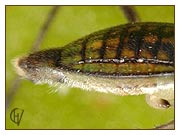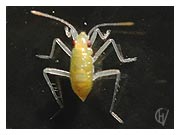THIS IS THE LEAST KNOWN SURFACE BUG. FEW PEOPLE HAVE EVER SEEN
ONE RUNNING ALONG THE BORDER OF A LAKE OR POND.

 Mesovelia has a water repellent hair coating, like all surface bugs.
Mesovelia has a water repellent hair coating, like all surface bugs.

 The typical, somewhat square head with the razor sharp sucking snout.
I too did only find one because I knew what I might find and so, while laying almost nose on
the water, spotted this 3 millimeter large dot, running on the water along the border of a
recreation lake. Because of their tiny size and the fact that hey are much less abundant then
Microvelias these bugs live unnoticed. They may be much more common than they are seen. Even the
great connoisseur Wesenberg Lund had to be made aware of the Mesovelias in his environment by a
colleague, before that he himself held them for larva of other species. Pondweed bugs can be
recognised by their greenish colour and the body shape: they are slimmer then the round
Microvelias. Maybe they are green because they stay a lot on floating leaves, for example those of
pondweed. The colour isn't always very visible because these bugs are quite glossy most of the
time.
The typical, somewhat square head with the razor sharp sucking snout.
I too did only find one because I knew what I might find and so, while laying almost nose on
the water, spotted this 3 millimeter large dot, running on the water along the border of a
recreation lake. Because of their tiny size and the fact that hey are much less abundant then
Microvelias these bugs live unnoticed. They may be much more common than they are seen. Even the
great connoisseur Wesenberg Lund had to be made aware of the Mesovelias in his environment by a
colleague, before that he himself held them for larva of other species. Pondweed bugs can be
recognised by their greenish colour and the body shape: they are slimmer then the round
Microvelias. Maybe they are green because they stay a lot on floating leaves, for example those of
pondweed. The colour isn't always very visible because these bugs are quite glossy most of the
time.
The scientific name means: "middle Velia", probably meaning this tiny bug is sized between Microvelia and the Water cricket. However Mesovelia has been put in its own family, the Mesovelidae. But Mesovelia does have the typical backward bended legs of the Veliidae family. They can run surprisingly fast with it and even jump short distances forward. But most of the time they rest on the border of a leaf or on a stem and walk at ease now and then, the legs are moved alternated. The hind leg and front leg on one side are moved at the same time, then the middle leg follows. Pondweed bugs have the same sharp sucking beak (proboscis) other surface bugs have, it is stabbed in small insects that fell on the water, which are then sucked out. Of Mesovelia mostly wingless (a-pterous) specimen are found, but now and then there are fully winged (macro-pterous)specimen that are able to fly and emigrate the species to new territories. The eggs (a mere 100) are inserted in plants. They sink to the bottom and in spring the tiny larva hatch.


The scientific name means: "middle Velia", probably meaning this tiny bug is sized between Microvelia and the Water cricket. However Mesovelia has been put in its own family, the Mesovelidae. But Mesovelia does have the typical backward bended legs of the Veliidae family. They can run surprisingly fast with it and even jump short distances forward. But most of the time they rest on the border of a leaf or on a stem and walk at ease now and then, the legs are moved alternated. The hind leg and front leg on one side are moved at the same time, then the middle leg follows. Pondweed bugs have the same sharp sucking beak (proboscis) other surface bugs have, it is stabbed in small insects that fell on the water, which are then sucked out. Of Mesovelia mostly wingless (a-pterous) specimen are found, but now and then there are fully winged (macro-pterous)specimen that are able to fly and emigrate the species to new territories. The eggs (a mere 100) are inserted in plants. They sink to the bottom and in spring the tiny larva hatch.
The larva look a lot like the adults and turn into the imago after five moultings. Because
of their small size a little uprising margin of water (meniscus) against a plant stem means
a high, slippery slope to them, comparable with an icy skiing piste to us.

Mesovelia larve, just after moultingThey have developed a special technique to slide upwards(!) against it. They achieve this by
pulling on the water surface with their front and after legs in stead of pushing it down. The
forces thus generated pull them up against the meniscus slope. A link to a very interesting
article with photo's, drawings and movies on this subject is at the bottom of this page. At the
end of the year all larva have turned into adults. Some researchers say there are two generations
each year, others say only one.

Mesovelia larve, just after moulting
WEBLINKS:
Article with photos and a
drawing of a Mesovelia larva sliding UP the slope of a meniscus.

back to: SURFACE BUGS
Page track: INDEX » surface bugs bugs » Mesovelia
COPYRIGHT:
All pictures on this site were made by Gerard Visser (Aadorp,
Netherlands), unless stated otherwise. All rights remain with him. These pictures may not be
used for purposes any other than private viewing or printing. Do NOT hardlink to these pictures
or place them on other websites without the author's approval. Should you need them for purposes
which include third parties, you must ask the author permission by e-mail. People, who want to use this pictures for exhibitions or
publications or educative material are much encouraged to do so, after approval as mentioned and
giving the normal credits.
© G.H. Visser 04-02-2007rev. 04-06-2007
Deze pagina in het Nederlands
https://www.microcosmos.nl

